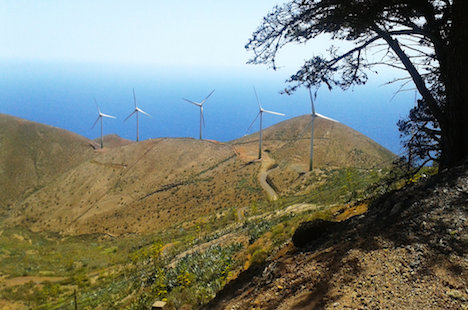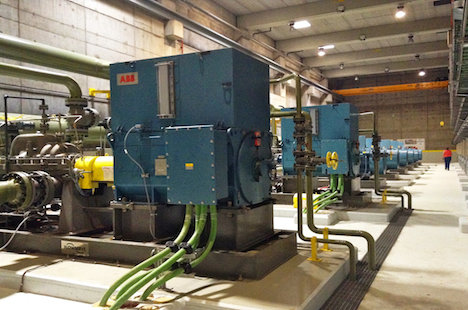|
By Lauren Frayer, NPR
NPR
Monday, Sep 29, 2014
 |
| Five industrial wind turbines form part of the Gorona del Viento power plant on the island of El Hierro. By the end of this year, the power plant is set to generate 100 percent of the energy El Hierro needs, making it the world's first energy-independent island powered only by renewables. (Lauren Frayer for NPR) |
It actually takes quite a lot of fossil fuel power to reach the tiny Spanish island of El Hierro. You have to catch a commercial jet flight, a propeller plane and then a ferry to reach what was once the end of the known world, before Columbus set sail.
But once you're there, there's no need for fossil fuels at all. The ancient island off the west coast of Africa is now a model for the future, within months of running on 100 percent renewable energy, which consists of a mix of wind and hydro-power.
El Hierro, the most remote of Spain's Canary Islands, is now billing itself as the world's first energy self-sufficient island that has never been hooked up to a power grid.
A Danish island, Samso, is also energy-independent, but was previously hooked up to the Danish grid and didn't make the change in isolation, like El Hierro.
Because of the topography of the surrounding seabed, El Hierro, an active volcanic island with a population of about 10,000, could never hook up to Spain's power grid.
Instead, it used big barges to ship in 6,600 tons of diesel fuel — the equivalent of 40,000 barrels of oil — each year, to power electricity generators. It was an expensive, time-consuming and dirty endeavor ... until now.
This past summer, El Hierro inaugurated the Gorona del Viento power plant, a $110 million wind and water turbine farm. By the end of this year, the plant will generate all of the island's energy needs of up to 48 gigawatt hours per year.
On days with little wind, water stored in El Hierro's upper reservoir is released through a pipe that cuts through the rocky hillside, falling through turbines and into this lower lake, for storage. On days with surplus wind energy, this water is pumped up the mountain to the mountaintop lake, for storage.
 |
| On days with little wind, water stored in El Hierro's upper reservoir is released through a pipe that cuts through the rocky hillside, falling through turbines and into this lower lake, for storage. On days with surplus wind energy, this water is pumped up the mountain to the mountaintop lake, for storage. (Lauren Frayer for NPR) |
The plant consists of five big industrial windmills and two lakes. On windy days — and there are plenty — the windmills harness the Canary Islands' Atlantic gusts. When production exceeds demand, such as at night, excess energy is used to pump water from a sea-level lake up into a natural volcanic crater half a mile uphill.
When the wind dies down, the water is released down through a pipe connecting the two lakes. On its way, it passes through turbines, which generate hydro-power.
Everything is connected with sensors so that within five seconds of the wind dying down, the hydro portion of the plant kicks in. For island residents, the lights don't even flicker.
The technology used in both the wind and water portions of the plant is simple, but El Hierro is the first to combine the two components, says Juan Manuel Quintero, an engineer who serves on the board of the Gorona del Viento plant.
The equipment used in the new power plant, like this machinery attached to the wind and water turbines, isn't new or revolutionary. But the island combined the water and wind power in an innovative way, insuring an uninterrupted energy supply for the island's residents.
 |
| The equipment used in the new power plant, like this machinery attached to the wind and water turbines, isn't new or revolutionary. But the island combined the water and wind power in an innovative way, insuring an uninterrupted energy supply for the island's residents. (Lauren Frayer for NPR) |
"The wind machines, we basically ordered out of catalog; we didn't invent the technology. Same with the water turbines," Quintero says. "The innovation we made is hooking up the two systems together."
The Spanish government, a local university and a Spanish power company all collaborated on the project. Gorona del Viento is one of the last major efforts the Spanish government approved before the financial crisis forced it to cut all subsidies for renewable energy.
"We're lucky the crisis came when the project was almost finished," says Alpidio Armas, president of the El Hierro cabildo, a role roughly equivalent to that of a U.S. governor.
El Hierro has long been known as a place people emigrated from. It's a harsh outpost far from the Spanish mainland, in the middle of the Atlantic. But Armas hopes the Gorona del Viento power station could revitalize the place, and make local residents proud of their island.
"When they turn on the light, they think of the windmills moving and maybe they think, 'We are different than the rest of the world, because we are catching electricity from these windmills and not from conventional engines,'" Armas says.
The Gorona del Viento power station is the talk of the cafes in El Hierro's biggest settlement, Valverde. Many residents hope their island's new 'green' credentials might draw ecologically-minded tourists.
"It seems like a good investment for us, and everyone benefits — economically and environmentally," says local resident Ildefonso Santana.
It won't immediately affect their pocketbooks, though. Electricity prices are set at the national level, so El Hierro's residents won't pay less for wind and water energy than they were paying for diesel-generated power before.
But they will get energy security for the future, says economist Gonzalo Escribano of the Elcano Royal Institute, a think tank in Madrid.
"How much will be the price for oil in 20 years' time? We don't know! But we are sure that we will still have wind in the Canary Islands in 20 years time," Escribano says. "And the price, or the cost to generate an additional gigawatt, will be ... zero."
Meanwhile, El Hierro is already planning its next energy project. It wants all the island's cars to be electric by the year 2020.
Source URL
|
 Print This Print This

|

